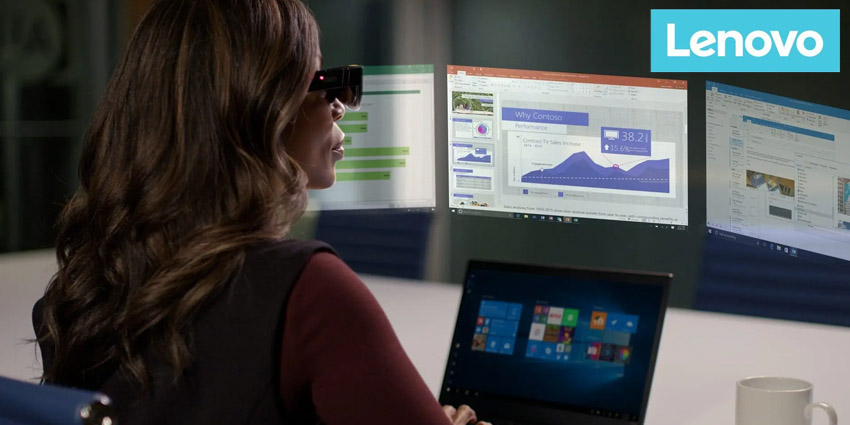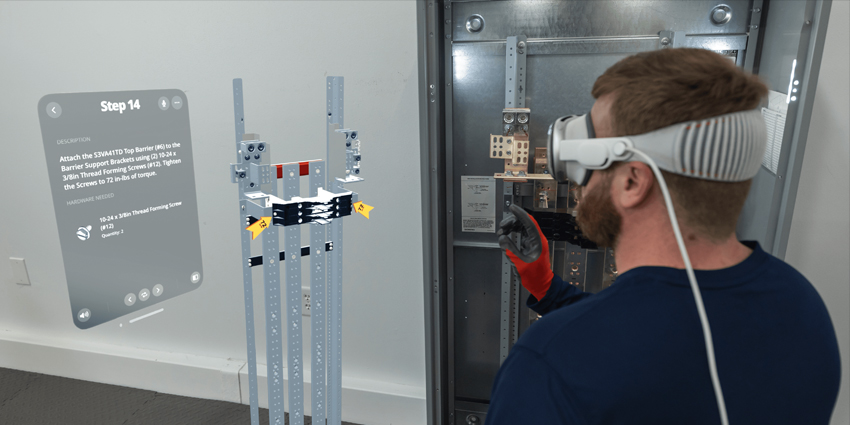Building the Metaverse and the industrial capacity to lead workforces with extended reality (XR) technologies requires hardware and software solutions that meet strict criteria and capabilities.
Lenovo’s ThinkReality series of devices, which have launched in recent months, aim to build the future of XR-empowered workforces and remote, deskless workers. In the age of the ongoing COVID-19 pandemic and the Fourth Industrial Revolution, such products have entered high demand.
XR Today spoke with Nathan Pettyjohn, AR/VR Lead at Lenovo and President of the Virtual and Augmented Reality Association (VRARA) and Immerse Global Summit, on the ThinkReality A3 augmented reality (AR) headset from the world’s largest computer firm by unit sales.
Can you explain how Lenovo helps organisations to deploy and scale up their VR/AR solutions, and in what capacities can they use your ThinkReality A3 to benefit their businesses?
Nathan Pettyjohn: As a brief overview, the ThinkReality A3 is one of the most versatile augmented reality devices to hit the market, as it was designed with a Snapdragon XR-1 chipset along with dual fisheye cameras. We also have a fitting kit that allows users to wear them for different head shapes.
The design provides the glasses with robust spatial awareness, but also a very lightweight form which tethers to the G100 Motorola smartphone as well as to PCs.
Tethering allows host devices to [offload] power and processing for the headset, but also leverages Android apps built for Motorola smartphones for display in the smart glasses, facilitating scalability and app porting capabilities on the A3 for developers.
Lenovo also has a software development kit (SDK) for full 3D spatial application development as well, which assists onboard developers. Going further, we have to consider hardware distribution, software, onboarding, and scalability along with the service in terms to implement those solutions.
Our focus on scalability has always been to give customers full solutions that can be deployed without going piecemeal on components and software, which Lenovo has taken on years of work to achieve.
Create a virtual monitor experience wherever you work. This is ThinkReality A3 — the most versatile smart glasses ever.
Learn more: https://t.co/ZZ5CGHv1aO pic.twitter.com/h8ty8nWMHN
— Lenovo (@Lenovo) May 19, 2021
Looking at the hardware aspect, Lenovo is known for having one of the world’s best supply chains in electronics and a very diverse and distributed network to deliver and ship them to many countries.
We recently announced the A3’s availability in roughly 28 countries, and we’re scaling that up to about 40 countries globally. Lenovo services and supports customers in over 180 markets around the world, so if we needed to increase our country scope where there is a strong demand from customers, then we have the ability to do that in short order.
If we look at the focus on software scalability, we can use our ThinkReality platform’s cloud services software, which provides devices and application management, user management, and other features similar to a lightweight mobile device management (MDM) platform.
We also integrate our MDM with other solutions such as Microsoft Intune, VMware, AirWatch, and several others. We have to consider IT professionals who may not want to change their MDM, but would like to use other services for thousands of their devices.
They may already have plugins that allow our ThinkReality system to work with AirWatch, and this is something we factor in to remove some friction.
There are also different suites of applications from what we define as ‘Certified Solutions,’ which are third-party apps subject to rigorous security and penetration testing, to meet very high standards.
After completing this, we allow customers to purchase third-party apps through Lenovo via a single sign-in to ThinkReality for all users, which also assigns them into apps with user authentication via the MDM.
We’ve really tried to break down barriers for customer adoption and scalability so that AR becomes an enabler for core businesses and not an obstacle.
Regarding XR, have you acquired any data or research which evidences why XR solutions are important for workers, such as with remote work, training, manufacturing, or other use cases?
Nathan Pettyjohn: For training, we have to consider input methods, such as whether it’s with virtual or augmented reality—Our Lenovo ThinkReality business encompasses both.
We have some data on VR related to our Mirage VRS-3 devices, and we actually have some really exciting case studies approved.
One particular case study was with Micron, a US company that produces memory storage solutions, and our findings evidenced how they could leverage ThinkReality technologies to manage a fleet of devices, allowing the firm to scale up their business operations in the future.
Micron implemented ThinkReality in just a few months, which placed the company in a strong position to tackle disruptions from the COVID-19 pandemic.
Our cloud-agnostic software platform also enabled commercial customers to build, deploy, and manage applications and content globally with our support.
Some statistics we promote include averages noted across several different customers. Regarding training, we’ve seen some studies back up this data, which show roughly 75 percent retention rates with VR versus 5 percent rates using traditional lecture-style learning environments.
According to a global study from Lenovo, roughly 50 percent of small to medium-sized enterprise (SME) employees responded smarter technologies such as VR and AR offered more efficient data processing and facilitated collaboration.
Additionally, by maximizing the full potential of workforces, boosts to efficiency in training processes helped SMEs and large business employers implement emerging technologies as a key to productivity and business continuity.
We’ve also seen learning times increase roughly 30 to 40 percent with VR, so there’s evidence of faster learning and retention, and when workforce personnel go on the job, on average, there’s 30 to 40 percent fewer mistakes after using VR training compared with conventional training.
We find that VR creates a sense of actually doing a job, because you’re completely immersed in the experience. It’s less similar to watching someone do the job as you feel you’ve done it before, and have encountered some of the errors during training and recouped from them.
The other thing we’re really excited about regarding the ThinkReality A3, which was released in late August, is that we’re hoping to see some great customers testing the device.
A nice aspect of the A3’s training element is that, due to the way the birdbath optics are designed, you have a very crisp, rich digital content displayed on the device compared to other devices on the market.
This means you can recreate digital twins or full 3D objects that are hyper-realistic and can be superimposed on the real world.
You can walk around digital objects and actually interact with them, offering more of a mixed reality type of experience. This leads to better training scenarios than just guided workflows or remote assistance, which the A3 does and is positioned well to be a great training tool.
Such solutions empower remote workers, who, according to our latest research, around 90 percent of respondents wanted the option of an office or meeting space to join colleagues, and 60 percent preferring to work from home at least 50 percent of the time.
This is especially important as demand for hybrid workforces could remain in place, and our research shows most employees are unlikely to return to a five-day working schedule.
The A3 also allows workforces to view and interact with up to five virtual displays in the smart glasses without the use of physical monitors.
Speaking on the device’s ecosystem and use of Snapdragon Spaces, we are working with many different third-party Internet Service Providers (ISPs) as well as 5G telco operators, which covers a very broad ecosystem across independent software vendors (ISVs), 5G telco solutions, and system integrators.
The #Metaverse is gonna need some seriously juiced #AugmentedReality capability. So it’s great to see @Lenovo & @Qualcomm join forces w/ @Snapdragon Spaces #Developer kit on ThinkReality A3 hardware. pic.twitter.com/FcQDfN0tuf
— MikeFeibus (@MikeFeibus) November 10, 2021
We’re also working with numerous chipset companies such as Qualcomm, who has stepped up and gone far beyond providing chipsets [and have launched] SDKs along with the new developer programme.
Two key partners are Holo One, our AR Certified Solution partner offering a suite of applications we provide, and a French company called Uptale, which has a VR training platform that allows you to go in and create semi-custom training modules on their platform for deployment on our Mirage VRS-3.
Their solution is focused on 360-degree VR training, but what we find is there’s still a really strong market opportunity for that. We offer one of three devices on the market that are all-in-one with 4K resolution, meaning it can scale very nicely.
We were also announced as one of the early partners of the Qualcomm Snapdragon Spaces developer programme, and initially, were the first company with a commercialised AR device to hit the market, so the developers in the initiative will receive ThinkReality A3 devices to build on.
In the Spring, they’ll expand to a much broader set of ISV partners we’re really excited about. They’ve announced around 10 to 12 different ones over the past few weeks, which we were a part of and are excited to work closely with [Qualcomm] as well as a lot of the application partners involved in that.
We’ve followed a lot of big developments with Lenovo, such as their partnerships with Varjo Technologies and RealWear. What do you expect Lenovo to achieve in the near future, both through its partnerships and new solutions?
Nathan Pettyjohn: Lenovo is very honoured to receive Time Magazine’s ‘Best Inventions of 2021’ award, and our goal right now is to be seen as one of the best-in-class enterprise solutions for AR/VR.
In 2015 I left academia and moved to industry with the goal of working on #AR projects that come to live and become part of our everyday life. First at #Lenovo then at #Google. Today, the two projects I worked on since I left are part of Time magazine’s best inventions of 2021.
— Juan David Hincapié-Ramos (@jhincapie) November 11, 2021
We want to prove that with a great product, a great service, and software, and we’re excited to deploy that to a lot of customers globally, but ultimately, we want to help companies become more efficient, see a return on investment, and do so at scale.
Success for us is to deliver those solution to our customers, and as we look at our core strategy with ThinkReality, it’s key to deliver flexibility, scalability, and security—our three themes to deliver to our customer base.
We’re excited to see the ThinkReality A3 deploy at scale and market, and are starting to see a lot of uplift with really great companies around the world who are purchasing the device and software platform. Hopefully, over the course of 2022, we’ll have many kinds of case studies we can showcase to the world.







